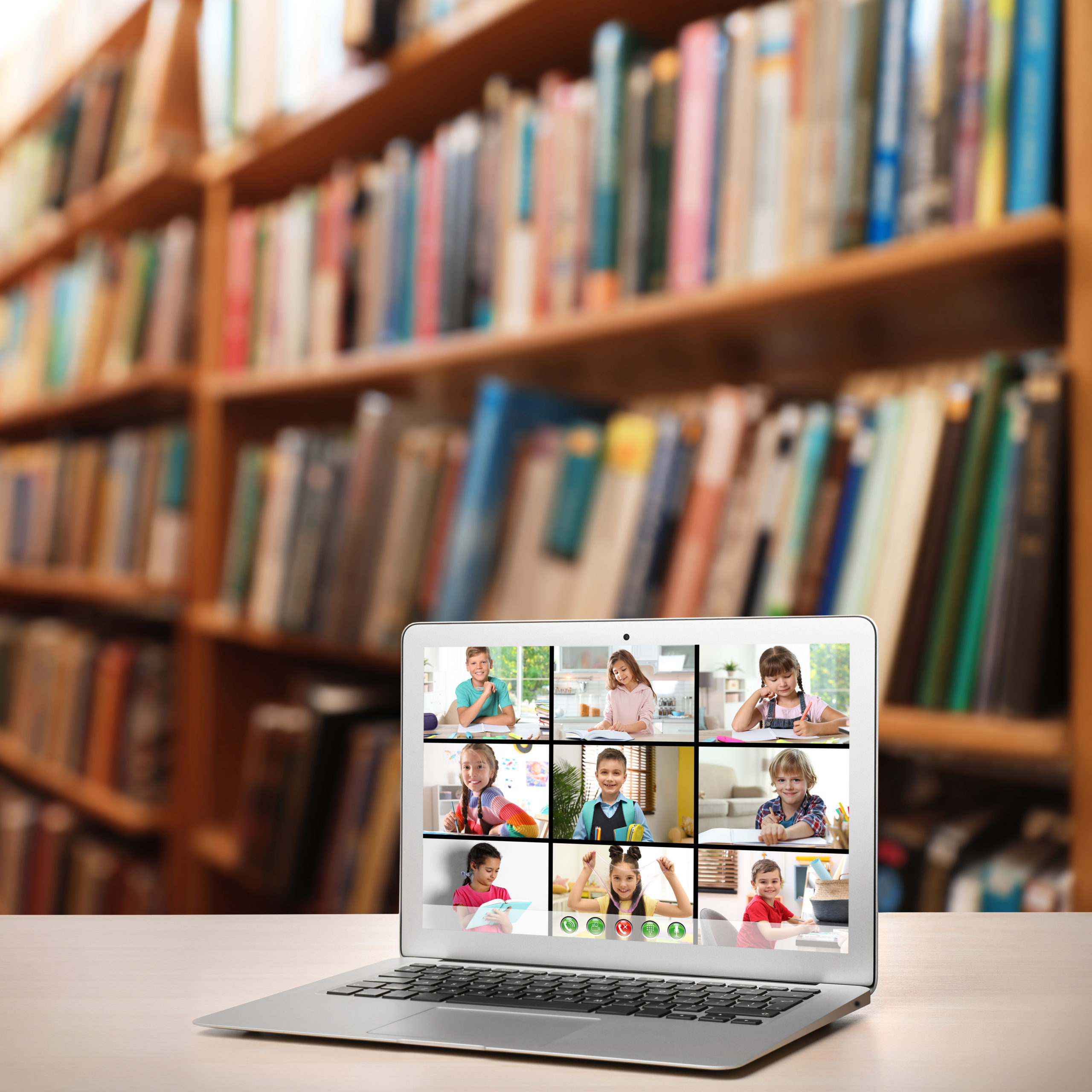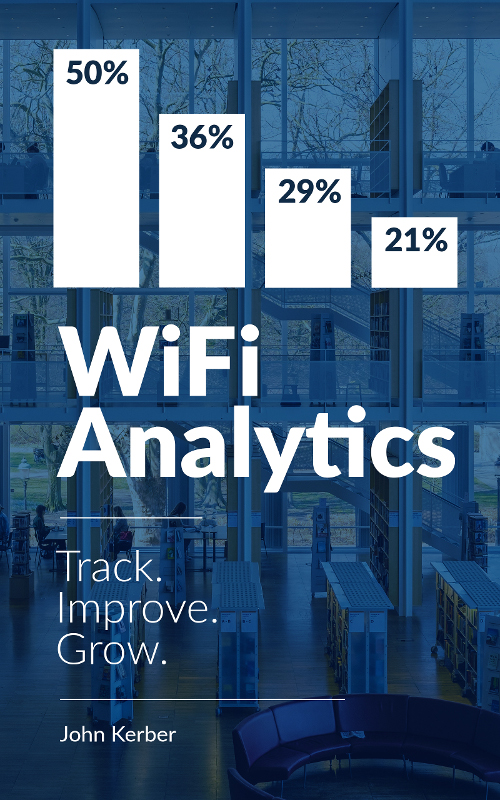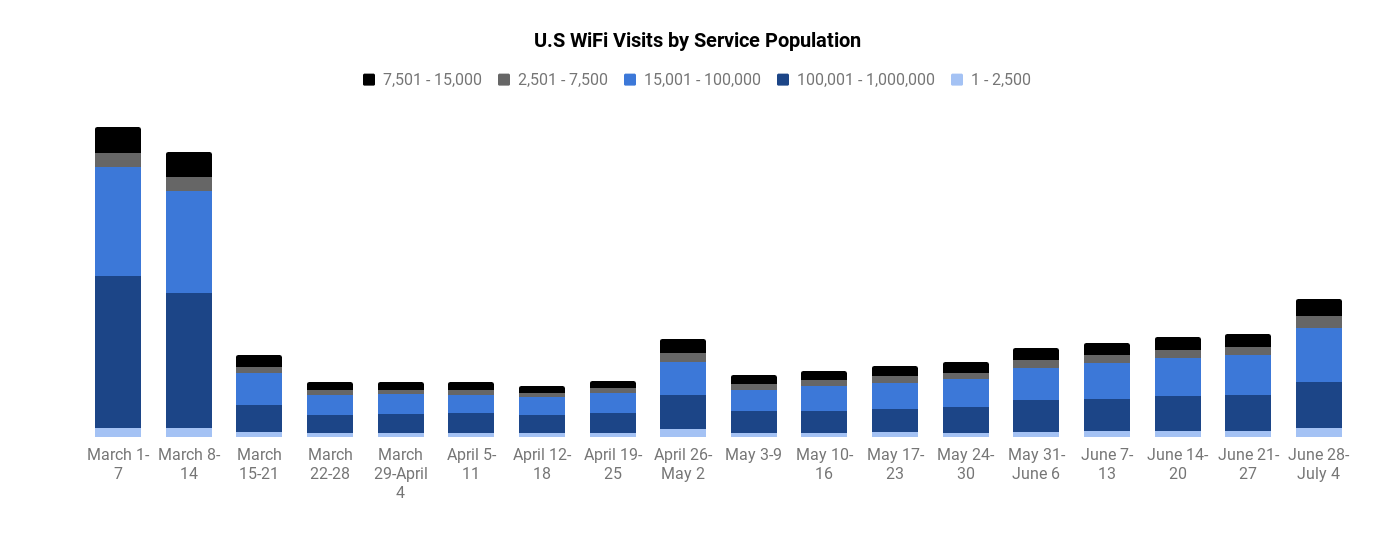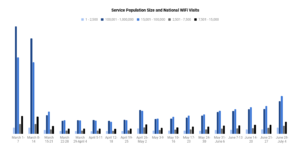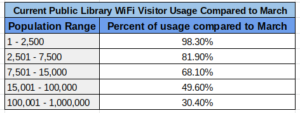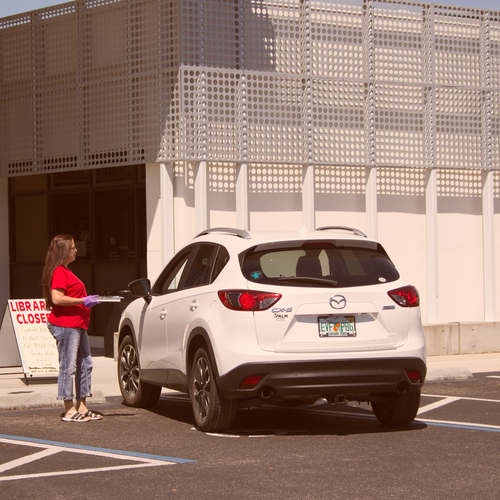9 Community Engagement Ideas for Public Libraries During COVID-19
This year has been challenging for public libraries and communities. Libraries were tasked with managing shutdowns while recreating their programming and services for an online space. Fortunately, libraries were well-equipped to manage the changes and meet community needs. Communities need their libraries more than ever. Public libraries are essential during these challenging times. Are you looking for ways your library can expand community engagement? Here is a shortlist of ideas to enhance public library community engagement.
#1. Amplify Curbside Services
Many public libraries are offering curbside pick-up services as a way to continue book loaning service. Patrons can use their library account to reserve books and follow their library’s curbside pick-up guidelines once the hold has arrived. And to replace in-person browsing, some libraries will select books for you or your child based on age, interest, and topic of choice.
Curbside isn’t just for books. Libraries are offering curbside office services like printing, copying, faxing, laptop lending, and mobile hotspot check-outs.
It’s also a great way to offer other materials the library offers – like children’s crafts or DVDs. Some libraries are pre-packing children’s crafts and activities that would normally be offered during a program and making them available for pick-up. Others are circulating DVDs by creating themed movie night packs that include DVDs and popcorn.
Take the opportunity to cross-promote your library’s other services each time a patron picks up an item from your library. Create hand-outs that outline your services and include a calendar of online events. For example, if a parent picks up a themed book bundle, be sure to include information about early literacy take-home kits, or information about virtual storytimes. Curbside service is a top pick for many locations that want to enhance public library community engagement.
#2. Boost Online Programming
Prior to the pandemic, libraries offered a variety of in-person classes ranging from baby and me playtime, yoga classes, exercise classes, gardening tutorials, author events, or music classes. Many of these can be recreated for the virtual format. The class teacher can host a live program using Facebook Live or Zoom, and post the recording to the library’s YouTube page so patrons can participate at any time.
To boost your online programming options, ask yourself these questions to generate new ideas or think of ways to recreate patron favorites for the digital space.
- What programs have been the most popular in the past?
- How can these be adapted for the online space?
- Can you invite yoga teachers to host online classes?
- What are some new concerns your community members might have right now? How can you best help them with these? Some examples are filing for unemployment or online job search.
- How can you collaborate with other community groups to cross-promote your services?
Ideas for popular virtual programs include:
- Toddler/preschool storytime
- Toddler/preschool music class
- Storytime dance parties
- Baby playtime
- Simple at-home STEM experiments
- Teen and adult book clubs
- Teen trivia night
- Self-care courses led by mental health professionals
- DIY face mask tutorial
- DIY gardening
- Local artist performances
- Keep kids safe online courses
- How to identify and combat misinformation courses
Virtual programming can be combined with curbside pick-up packets to replicate the library experience as much as possible. For example, baby playtime is beneficial because babies can interact in person with other babies and adults. And it’s beneficial for the parents, too, as the library teacher provides gentle instruction on activities to facilitate brain growth. So in this scenario, the library would package materials for parents to pick up then they can tune into the virtual library instruction. Librarians can complement virtual programming with circulating early literacy materials, math games, book bundles, themed take-and-make-kits, and also create visual boards with activities for people to do at home.
#3. Expand Digital Content
As part of the online programming efforts, libraries are letting patrons know the digital content available to them. Here are a few ideas.
- Promote digital content available to patrons with their library card. For example, apps or websites they can access with their cards like language learning sites, genealogy sites, and library databases.
- Provide library card sign-ups for access to remote resources.
- Provide references services via email, phone, and chat.
#4. Create Curated Content for Patrons
Think about your patrons' current needs. The library has the information and resources, so how can you package that material into something easily accessible? Librarians have so much knowledge about what the library has available for patron use, so simply finding it and presenting it together is immensely helpful for the community. Curated content is certainly a way to enhance public library community engagement because it shows that your library is listening.
Some examples of types of content in which patrons are interested:
- Articles, podcasts, or other pieces of information about creating an engaging home learning space, ways to help kids with online learning, and the like.
- Books, stories, and articles about building resilience and getting through hard times.
- Information about dealing with stress, anxiety, and depression and resources to seek help.
- Articles and resources for job seekers and those looking to learn a new skill.
- Literature about the history of viruses or something with an interesting scientific angle.
- Easy read novels that provide a constructive way to manage stress and mental break.
- Hand-picked children’s books to help them understand and overcome difficult times.
- Books and resources about home learning for preschool children, since many parents may be doing more child care if group care is unavailable.
#5. Recreate Physical Spaces and Services for Digital
Prior to shutdowns, libraries offered free meeting spaces for individual and group use. A remote worker could use the space to work, or a group of workers, volunteers, or anyone who needed to gather could use a meeting room. Some rooms were equipped with AV technology for presentations. So now since patrons can’t use the library in this way, some libraries are adapting spaces for online use via Zoom. Patrons can reserve a room for a certain amount of time in the same way they would for in-person use. In addition, libraries can make office services like printing, faxing, and copying available with curbside pick-up. And laptops and hotspots can be available for check out with a library card.
#6. Bridge the Digital Divide
Libraries have long been at the forefront of the efforts to bridge the digital divide. Their accessible-to-all technology and free WiFi are a mainstay for many patrons, many of whom rely on the library as their primary source of internet. Now in the coronavirus times, access to the internet is even more critical. Here are some ways to continue the effort toward digital equality and enhance your public library community engagement.
- Keep the library WiFi on 24/7 (per ALA recommendation).
- Promote that your free WiFi service is available and explain how patrons can use it.
- Leave instructions on how to connect to the WiFi in the windows or signs visible outside.
- Purchase wireless hotspots for library staff who don’t have access at home and patrons to check out.
- Miss your library regulars? Reach out via phone or email and encourage them to connect with you on social media.
- Think about other places in the community where you can promote your free WiFi and other library services (schools, homeless shelters, women’s shelters, crisis centers, community centers, health clinics.)
- Include information about technology and WiFi services in all other materials and online (your website, social media, curbside checkouts.)
#7. Help With Internet Skills
Use web recording tools like Loom or Zoom to record tutorials on how to apply for unemployment, order online groceries, or other internet tasks that many people may be unfamiliar with. Providing these services and help is something library staff would ordinarily do in person, using the library’s computers, but now patrons are at home.
#8. Communicate that the library is an essential service
- Determine how the library can promote remote services best to your community.
- Use alternative methods to promote these services to patrons who aren’t already connected. If someone doesn’t have access to the internet at home, it’ll be difficult for online communications to be received. So work with community groups to help get the word out about free library WiFi, hot spot loans, loaning technology, and whatever other services you’re offering. Or even post signs in the library windows.
- Reach out to your local news outlets to have your library featured.
#9. Librarian professional development
- Seek out and participate in professional development. Some librarians are learning a new skill, such as video editing, which can be useful now and in the future.
- Librarians can also connect with colleagues through association groups, connect with other community leaders, support legislative advocacy, and share what’s working for your libraries with other locations.
- Consider submitting a blog or article to an industry publication to share your ideas, insights, and experiences.
WhoFi helps real-world spaces understand and engage with their patrons within the building and beyond. Would you like to learn more about how WhoFi partners with public libraries? Schedule a demo today.
Navigating the Changing Landscape of Public Library Programming During COVID-19
Libraries across the country are stepping up in a time of crisis. As we continue to adapt to this new (ab)normal reality, libraries shift their programming model to reach beyond their physical buildings and provide essential services for their communities. How are librarians navigating the changing landscape of public library programming during COVID-19?
Innovation during times of crisis can lead to lasting positive change for public library programming.
Librarians are innovating new ways to stay connected and serve the community by adapting in-person programming to outdoor events, curbside projects, or online programs. Using a mix of social media platforms, such as Facebook (live and stories), Instagram, Zoom, and YouTube, public libraries are able to provide a wide range of programming.
Community programs like children’s storytime, summer camps, and craft time have moved online for socially distanced access. Instead of in-person interaction, librarians are reading books, demonstrating crafts, or leading tutorials online. Other library services have changed too. Pre-COVID we could enjoy the library space as just a place to go and be in an enriching environment, whether there was a planned program or drop-in visit. Often parents would leave with a few books the kids selected, or a craft that the children’s librarians lovingly prepared.
Now, that thoughtfulness and care continue, just in a socially distanced way. Parents can request a book bundle for grab-and-go or curbside pick-up, specially selected by local librarians based on your child’s age and interest. Take-home craft projects can be picked up grab-and-go style or curbside pick-up. Librarians are recording themselves teaching parents how to recreate the library children’s programming from their own homes.
We’re all finding ways to stay connected while being physically apart. And the result has been positive.
The demand for digital content has soared since the pandemic began. More patrons are attending online programming. The feedback has been good and these services will likely stick around to make the library more accessible to more people.
Public libraries provide essential services in a time of uncertainty.
One of the key missions of public libraries is to provide services to all communities, regardless of background or socioeconomic status.
All are welcome here.
During times of crisis and upheaval, the community relies on the library even more. The need for information and digital access are even greater. Americans already consider libraries essential to communities. People see libraries as a safe space, a source of educational opportunity, a source of trusted information, as well as a place to ignite creativity and curiosity in youth.
A recent report from NPR states that since shutdowns began in March, the use of library services increased dramatically. Digital book loans have skyrocketed particularly children’s e-books. Many libraries made online library card applications available and expanded access to e-books, databases, and e-resources. Since buildings were closed to the public, libraries extended their WiFi signals and offered ‘drive-up’ WiFi so patrons can still use their internet from a safe, socially distanced space.
Many people in communities turn to the library for guidance and help with online tasks that they’re unfamiliar with, or need to borrow the library computer and internet connection to complete. Things like filing for unemployment, seeking government services, applying for a job, and basic internet skills are all areas in which a librarian would otherwise help a patron in person. Now, librarians are using web recording tools to record tutorials or talking patrons through the process via the phone. Library staff will do whatever it takes to help people.
Libraries offer a sense of normalcy in abnormal times.
When COVID forced libraries to close, library staff knew they wanted to establish a positive digital space for people to gather and continue to enjoy the programs they love. For many individuals and families, the library was part of their regular routine. So having a continuation of this in some way is beneficial. The public library programming during COVID-19 has been effective because people can still benefit from the community the library provides even while spending more time at home. Based on our discussions with library partners and observation, these library adaptations have been successful in meeting the community's needs, providing a much-needed mainstay in these uncertain times.
WhoFi helps real-world spaces understand and engage with their patrons within the building and beyond. Would you like to learn more about how WhoFi partners with public libraries? Schedule a demo today.
Libraries Can Improve Patron Experience By Expanding Digital Services Using E-Rate Funding
According to FCC reports, 24 million people in the U.S. lack broadband internet access. In the coronavirus times, the need for internet access is more important than ever. So how can libraries maximize their resources to improve the patron experience? The FCC’s E-Rate funding is one solution.
The E-Rate program makes telecommunications and information services more affordable for schools and libraries. The ongoing proliferation of innovative digital learning technologies and the need to connect students, teachers, and workers to jobs, education, social services, and information has led to increased demand for bandwidth.
COVID-19 and expanding digital services using E-rate funding for libraries
The IMLS is distributing $30 milling in funding to libraries across the U.S. as part of the CARES Act in response to the impact of COVID-19. States will be able to use the funds to expand digital network access, purchase internet accessible devices, and provide technical support services to citizens to address digital inclusion efforts. Rural schools and libraries may also receive more funds to get the internet. It’s worth noting that rural service areas have the highest percentage patron use of library WiFi, according to our national data.
How can WiFi insights support your library’s need for E-Rate funding?
Our library partners use WiFi analytics as a way to accurately count WiFi sessions, both for PLS reporting and internal library advocacy. They’ve also used the insights for program selection and layout changes.
Now due to COVID-19, libraries are adjusting how they serve patrons. Many libraries made WiFi accessible 24/7, which was later an official recommendation from the ALA. This was a smart move and allowed our partner libraries to understand how their patrons were using the service. WiFi analytics showed there was continued activity even though libraries were closed to the public. What this told us was that patrons still needed to use the library for WiFi access. But now instead of being inside the building they were sitting outside, in the parking lot, and using after hours. Understanding how and when patrons are using a service is key to making sure libraries are equipped to continue and expand this service.
What can we learn from WiFi insights in the time of coronavirus?
Let’s start with what we know. We know that patrons are continuing to use library WiFi services. We know there is an increased demand for internet access since many schools and jobs have moved online. We know that millions of Americans lack sufficient internet at home. And we know that the library is often their primary source of internet.
According to a Public Library Association (PLA) survey, 98% of respondents reported their buildings were closed to the public but staff continued to expand digital products and launch virtual programs. Creative ideas keep communities connected – like offering “drive-in WiFi”, expanding digital access, moving adult and children’s programming to an online format, and offering all kinds of digital resources. It seems like this will be the norm for the foreseeable future, so libraries need the bandwidth to support the increased patron need and their own programming. This is how E-Rate funding can help libraries improve the patron experience.
How to apply for E-rate funding for libraries
Applying for E-rate funding can seem complicated, especially if it’s your first experience with the application process. If you’re a public library applying for E-rate funding, here’s what you need to know about the application process.
Who runs the E-rate funding program?
According to the FCC website, the E-rate program is administered by the Universal Service Administrative Company under the direction of the FCC. USAC is responsible for processing the applications for support, confirming eligibility, and reimbursing service providers and eligible schools and libraries for the discounted services. USAC also ensures that the applicants and service providers comply with the E-rate rules and procedures established by the Commission.
Where do I fill out the E-rate funding application for my library?
The USAC website has a step-by-step guide to follow. It also outlines the process for applicants and providers so you have a full understanding of how the system works. On the USAC website, there is a ‘Get Started’ web page that details your next steps. You will need to set up an account on the E-rate Productivity Center (EPC) to fill out your application through this application management portal. There are also E-rate consultants that can help you apply for funding such as Funds for Learning that can help guide you through the process as well.
How does a library WiFi strategy help with planning for the post-COVID future?
Creating and implementing systems to meet community needs during a crisis will carry forward in positive ways in the future. Public libraries will be even more well-positioned to lead the way in bridging the digital divide. Libraries will have a game plan for the next crisis and the tools necessary to respond quickly. Public libraries will continue to provide a valuable and necessary service to everyone by being thought leaders, community advocates, and coming up with creative solutions.
Want to know more about WiFi insights for your library? Book a demo today!
WhoFi Customers Can Download WiFi Analytics Book For Free
Exciting news for our WhoFi partners: our recently published book, WiFi Analytics: Track, Improve, Grow, is now available to all customers as our gift to you. You can access your digital copy of the WiFi analytics book by logging into your WhoFi dashboard and going to the monthly report section.
At WhoFi, we strongly believe that insights gained through WiFi analytics can improve communities and strengthen public spaces. This is why our co-founder, John Kerber, recently published a book about WiFi analytics and how it helps real-world communities. We’re very excited to release it to all of our customers!
What’s the WiFi analytics book about?
This book explains all about the emerging and exciting technology of WiFi analytics in an easy-to-read format. WiFi analytics is a tool to help create strong communities. This technology can transform your community space or public library while building trust through maintaining visitor privacy. The book covers topics including which industries are using WiFi analytics and what hardware, software, or service you need to get started. You’ll learn more about the specific technologies that work together to improve public venues and communities, such as social WiFi, foot traffic, guest WiFi, WiFi marketing, and presence analytics. There’s also special coverage on user privacy so you can ask smart questions and make informed decisions.
WhoFi helps real-world spaces understand and engage with their patrons within the building and beyond. And when your community is spending more time at home, keep them engaged and connected. With the insights we provide, you’re more prepared to meet organizational needs with proper staffing, programs, and resources to meet community needs.
Whether you’re a long-time customer or just started with our service, this book can provide valuable knowledge so you can better understand the power of WiFi analytics and how to use it to improve and serve your community. If your library or community space recently gained a new director, this book would be a great asset to share.
How to download your ebook
- Login to your WhoFi customer account.
- Navigate to the monthly reports section.
- Here, there will be a downloadable version of the book.
- Click and save to your computer or device.
Want to know more about WhoFi and how we partner with you to improve communities? Visit our website, or book a demo.
Why Libraries Need High Speed Internet
During COVID-19, high-speed internet is a life-line — that millions of Americans lack. Libraries need high-speed internet to better serve communities. Lack of internet access in some communities has been a problem since the explosion of the internet. Now, during the coronavirus pandemic, lack of internet access is creating wider gaps between those with access, and those without.
It means the difference between students being able to get an education, or not.
Workers being able to maintain their jobs, or not.
People being able to access social services and health information, or not.
This pandemic is highlighting and exacerbating inequalities that have always been a problem. One in which public libraries are on the front lines of service. The need for internet connection now is critical.
The ability to connect to the Internet has been recognized in a number of countries as a human right, or at least as a core public interest utility. Internet access is considered a platform in which an individual can access the tools and skills necessary to improve their lives and participate in the economy and access government. In coronavirus times, it also means it’s how we go to school and work.
Now with social distancing measures in effect for the workplace and schools, access to the internet is absolutely necessary, yet according to FCC reports, 24 million people in the U.S. don’t have broadband internet access.
There is a solution – make sure all public libraries have high-speed internet.
Libraries need high-speed internet because the demand for access is increasing and needs to be met with enough bandwidth to support it.
Although libraries report increases in their connection speeds, they continue to report that their connection speeds are insufficient to meet patron needs some or all of the time. This is of critical importance, especially now during the COVID-19 pandemic, which is changing the nature of work. Currently, 77 percent of the workforce is working remotely at least one day a week. And school districts are extending remote learning into the fall semester as the pandemic is uncontrolled in many areas.
Lack of connectivity disproportionately affects vulnerable and rural populations. Right now, 45 percent of low-income families and approximately a quarter of rural communities do not have access to broadband. These communities often rely on the public library as their primary source of internet. Yet this study shows that rural libraries have the slowest internet connection speeds. So when schools are closed and the classroom moves online, libraries need to have the bandwidth to accommodate patron needs.
Libraries Move Their Programming Online
According to a Public Library Association (PLA) survey, 98% of respondents reported their buildings were closed to the public but staff continued to expand digital products and launch virtual programs. While nothing can replace the real-world library experience, libraries have done a good job adapting to continue to serve communities. Creative ideas keep communities connected – like offering “drive-in WiFi”, expanding digital access, moving adult and children’s programming to an online format, and offering all kinds of digital resources. Since it seems many areas will continue to operate this way, library staff need high-speed internet just to be able to continue to provide these online services.
The homework gap expands
Twelve million school children don't have sufficient internet access at home to finish class assignments. The digital divide expands and creates a phenomenon called the homework gap. Now that schools are doing remote learning instead of in-person instruction, this means the kids without reliable internet are receiving little to no instruction at all. This could have negative implications for years to come and perhaps create a generational problem.
While there are other factors to consider, such as access to transportation or adult involvement in children’s education, the public libraries in all communities need to be able to handle the increased stress of the coronavirus reality. This helps the community stay afloat while we work as a nation to close the digital divide.
The coronavirus has made the disparity in access glaringly obvious. It’s not something we can ignore. High-speed internet access is no longer a privilege, it’s a necessity, and many Americans are lacking. Right now, public libraries are on the front lines. They're in a position to be able to adjust and adapt, relatively quickly, and provide this service to the communities.
Many libraries have already adopted drive-in WiFi and created accommodations for patrons to access the internet while social distancing. We can lessen the blow to the most vulnerable communities during this time of crisis by equipping all public libraries with high-speed internet. It's the most centralized, quickest way to help more people get internet access.
Public libraries provide access to technology and a safe space to learn and work.
In areas where communities rely on the library for internet access, many people also lack the proper technology to complete work, homework, or other tasks. Applying for jobs, watching school videos and completing assignments, or applying for social benefits requires more than just a smartphone. Libraries have always been a place where school children without home computers can do homework and get online. Now that many more people in the community need to use the library services and WiFi to file unemployment claims, make doctors’ appointments, attend telehealth appointments, and other necessary tasks, the load on the library WiFi is increasing.
Many jobs require online applications. Government agencies also increasingly require individuals to go online for critical services and resources. To meet this growing community demand, public libraries require reliable, affordable, and high-quality internet access.
Some libraries are now opening in phases and offering access to computers and printers in a limited capacity to adhere to social distancing guidelines. This is something to consider as libraries navigate the next phase of library service.
Remote work is here to stay
Even before the pandemic, remote work was on the rise, with more than one-third of the U.S population doing remote work. A U.S. Bureau of Labor Statistics report estimates that 37 percent of the workforce can be entirely remote since their jobs don’t require operating equipment or being face-to-face with customers, like the service industry or medical jobs.
Freelancers, contractors, and remote workers of all kinds could benefit from using a workspace that is outside of the home. Many households now have both partners working from home while also caring for kids, which is challenging. Having space to work outside of the home could relieve some of the pressure.
Planning for the post-COVID future needs to include a library WiFi strategy.
We’re now six months into the COVID crisis and the data is clear that social distancing measures will be in place for the foreseeable future. Many schools across the country have already made the decision to do online learning for the first semester. Access to high-speed, reliable internet is a critical component for students and workers right now. Equipping our libraries with the bandwidth needed to meet this increased need can help relieve the pressure on communities and individuals and help students and workers be successful. Creating a broadband structure in every city and town is a big undertaking, and we need access now. Libraries are already in a position to be able to offer this.
Would you like to know more about how WiFi analytics can benefit your library or community space? Book a demo and read what our partners are saying about us.
Special Report Update: Effects of COVID-19 on Public Library WiFi Use
Early in the coronavirus pandemic, WhoFi released a special report about the effects of COVID-19 on public library WiFi use. We analyzed library WiFi usage during March – the month that many libraries closed their buildings. This report consisted of consolidated data from our library partners across the U.S. to provide a better understanding of the national response to the COVID-19 outbreak and the effect on public library WiFi use.
A PLA survey report showed that 98% of libraries closed to the public in March due to COVID-19. However, the WiFi data from our insights showed a national decrease in WiFi usage of only 67%. This shows patrons were accessing the library WiFi in other ways besides actually being in the physical library building. The same PLA survey also noted that 81% of libraries decided to leave their WiFi on and available to the public. Since a high number of libraries left WiFi on, the drop in usage of only 67% makes sense.
Our data shows that between the first week and last week of March, visitor usage dropped significantly, then leveled. These WiFi usage trends correlated with key dates in the coronavirus timeline.
In our Special Report Update, we used the same parameters as our initial report: gathering insights from all of our library partners combined to identify national trends, changes based on population size, and if there were any key dates that correlated with changes. Essentially, what has been the public response since the onset of the pandemic, and did library service adaptations seem to affect behavior?
Library WiFi Insights Have Shown Increased Usage Since March
Our data shows that after the initial drop in WiFi usage in March, trends steadied and then began to rise around April 26. In fact, there’s a steady increase in WiFi usage nationwide and across cities and towns of all population sizes. Library efforts to enhance and extend WiFi services, paired with a solid communication plan, seem to have the desired effect of helping patrons stay connected. The total number of visits, however, isn’t as high as it was prior to shut-downs.
The national WiFi usage rates were down 70% in April from the average of previous months usage rates. By the end of June, the national WiFi usage rates increased 40%. On March 23, the ALA officially recommends libraries leave WiFi on. Our insights show that from March 15 to April 19 library WiFi usage remained about the same across population sizes. A consistent effort by the libraries to promote their continued and extended WiFi services helped communities use the service. Since then, there’s been a consistent increase in usage.
Library Service Area And Patron WiFi Needs
In our first report, we analyzed data by comparing urban and rural service areas to determine if there was a difference in WiFi usage across the population sizes. Our data showed that library WiFi use in urban areas had the greatest decrease, although both urban and rural service areas showed a drop. There are a variety of social, cultural, and economic factors that contribute to these numbers, as we learned from conversations with our library partners. There’s also plenty of national data referencing how the digital divide contributes to this.
Patrons in rural service areas often rely on the public library as their main source of internet.
Rural service areas have a higher percentage of the population that uses the library WiFi and showed more stable usage patterns since March. When schools moved to an online learning model for the remainder of the 2019-2020 school year, students needed a reliable source of internet to complete schoolwork. Libraries and school systems come together to bridge the gap and provide critical services for those who need them. The library has been a place for school children to use library computers to complete homework. Now, with library buildings closed, they don’t have access to computers or WiFi. Schools and libraries are working together to loan laptops, provide mobile hotspots, and extend WiFi reach in library parking lots.
Breakdown of WiFi usage rates by service population size
The graph above shows the WiFi usage rates of each population size from March 1 to July 4. The most drastic change in usage rates was in the 100,000-1,000,000 population size group, which still hasn’t regained half of its previous WiFi usage rates. Another interesting metric is the 1-2,500 population size group, which has now regained nearly all of its previous WiFi usage rates. Smaller population areas have also recovered a higher percentage of WiFi use compared with numbers from March. See the graph below.
Timeline of events, key dates, and COVID-19 effects on public library WiFi use
In our initial report, data showed that there was a clear change in WiFi usage between March 11-15, which correlated with national events related to the coronavirus. There have been significant events since that surrounding the increasing number of coronavirus cases and economic impact, see bullets below. However, there isn’t a clear correlation between WiFi usage rates and specific dates. It’s worth noting that as these events unfolded – increased cases and increased unemployment claims – so, too, did public library WiFi usage rates.
- April 16 Around 5 million more Americans filed for first-time unemployment claims.
- April 18 More than 700,000 people in the United States have tested positive for coronavirus.
- April 23 Another 4.4 million Americans filed unemployment claims, bringing the total to more than 26 million claims.
- May 17 The number of coronavirus deaths in the United States surpassed 90,000. Confirmed cases in the country also rose to nearly 1.5 million.
- May 21 Another 2.44 million Americans filed for initial unemployment benefits the week before, bringing the total number of people who lost their job so far during the coronavirus pandemic to almost 40 million.
- May 26 The World Health Organization said the Americas had emerged as the new epicenter of the coronavirus pandemic.
Libraries are important to communities, especially in times of crisis.
Even before the coronavirus outbreak, lack of internet access was a big problem. Now, it’s critical. Public libraries are on the front lines of this problem helping patrons stay connected to school, work, family. They’ve also been important for social services such as filing for unemployment and completing the census which requires a connection to the internet. The data is clear: WiFi is a valuable resource the libraries offer. Tracking this could prove to be beneficial in future library advocacy efforts. Questions about how to get insights for your library? Schedule a demo with our team.
Community Is Bigger Than A Building
Public libraries across the nation are struggling to reopen their doors, with 47% saying they’re unsure when they will reopen to the public. Libraries are places of community and connection for everyone. People rely on the library for more than books and videos. Libraries offer social services like literacy programs, U.S. citizenship classes, continuing education, housing, and tax assistance. Libraries have also become a safe haven for people experiencing homelessness who need to access social services or simply use the public bathroom. COVID helps us understand that our community is bigger than a building.
People want to feel close to a community even while being apart.
Libraries, and all community spaces, are the pillars of every community. When the COVID-19 pandemic swept across the country, spaces closed and people stayed in their homes. Social gatherings moved online, which helps us stay connected but doesn’t replace the real-world interactions. Businesses, community spaces, and public libraries adapted to the new normal and found ways to continue to serve communities. Since it seems like this will be the reality for a while now, adaptation is necessary to stay connected and continue to be the strong pillar communities need.
Staying Connected Beyond Buildings
Social distancing is hard because it’s contrary to human nature. Studies show that social connection is beneficial to our health, and lack of it is bad for our health. So much so that loneliness is considered a health hazard. Currently, people are experiencing a significant increase in depression and anxiety symptoms related to coronavirus. This common human experience is natural, considering human nature and our need for connection.
Libraries and public spaces help create a sense of community and connection. So when libraries make their services and programs available through alternative methods, this helps to strengthen the bonds between the individuals of the community and the library institution.
A Community Is The People, Not Just A Building
It does make a difference for patron experience to have an updated space, lots of resources, new technology, and all of the amenities a library provides. But right now the community can’t use these facilities. We can’t gather around for storytime, or scan the isles for a book that piques our interest, or use computers, printers or other office services. We don't get face time with friends and our favorite local librarian. We're unable to sip a latte while we watch the kids play in the children’s area. Patrons directly benefit from these activities that happen within the physical walls of our libraries.
Proactive library systems are right now shifting focus outside of the physical building and nurturing what actually makes up the community: the people.
The people are still here.
People still need programs and services.
People need a connection.
Recognizing and speaking directly to this will help libraries and other public spaces stay connected to the people they serve, and further endearing patrons' hearts to community institutions. Doing so can help us feel close even when we’re apart.
Here are 5 ways to stay connected to your patrons even when your doors are closed. Would you like to know more about how WiFi analytics can benefit your library or community space? Book a demo and read what our partners are saying about us.
5 Ways To Stay Connected To Your Community Even With Closed Doors
Human connection is something we inherently know we need, in some capacity, because of the very nature of our being. We are social creatures and rely on one another – our community – for survival. We need to stay connected to communities. Now that we aren’t gathering in public places, nurturing the community beyond the building is crucial.
Here are 5 ways public libraries can stay connected to their communities while doors are closed to the public.
1. Curb-side pick-up
Many libraries started an online checkout and pick-up program so patrons can continue to borrow books, movies, games, and, in some locations, technology equipment. This service lets patrons still enjoy borrowing while staying safe with a contactless pick-up. This practice also works well for patrons that need library services for unemployment forms, voting resources, or job-seeking guides.
2. Online Storytime and Programs
Children’s storytime is a beloved activity for many families. It’s enriching for the kids and is a safe activity for families. Being able to socialize with other kids is great, but when libraries close, online storytime is the next best thing. Kids can enjoy seeing their favorite library teachers read books which can help kids feel a sense of normalcy during uncertain times. Some programs for older kids can be moved to an online format, too.
TIP: Promote the page on your website and make signs for the library windows. Post online programs to your library’s Facebook page so they can be easily accessible.
3. Drive-in WiFi
Many people depend on the library WiFi as their main source of internet, especially in rural areas. So when doors close that is a big concern for the patrons who need access to the internet. To get around this problem while maintaining social distancing, libraries implemented a ‘drive-in WiFi’ practice. Patrons can sit in their own cars or outside the library while accessing the internet. Some libraries moved access points closer to the windows to extend the signal and began promoting this to the community so more people could use it.
TIP: promote this service on your website, Facebook page, and make signs for the windows with WiFi access information.
4. Online/curbside project pick-up
Since in-person library programs aren’t an option right now, these crafts and projects can be packaged up and available for curbside pick-up for families who want them. Or, create a downloadable version that can be printed and used at home.
5. Outdoor programs
As we learn more about the coronavirus and what activities are safe, it seems that outdoor, socially distanced activities are considered low risk. Libraries could offer outdoor storytimes or other programs using a reservation system to limit capacity and implement proper protective measures such as masks and social distancing.
Would you like to know more about how WiFi analytics can benefit your library or community space? Are you seeking ways to stay connected to your communities? Book a demo and read what our partners are saying about us.
How Do Communities Stay Connected When COVID Forces Us Apart?
Public spaces bring people together. Both urban and rural communities share a commonality–the collective use of shared spaces available to all members of the community. Public spaces like community centers, parks, and libraries are staple gathering places in every community. Other communal spaces like co-working co-ops and coffee shops bring people together, too.
When the coronavirus began to sweep across the country, once-bustling spaces became vacant. An eerie depiction of the effects the virus was having on our communities. State-wide shut-down orders were in place. Schools closed and moved to an online learning model. Many workers quickly adapted to remote work. Businesses closed or did curbside pick-up only. Families hunkered down trying to navigate the new reality that was quickly thrust upon us.
Social distancing is hard when humans are wired for connection.
Studies have proven that social connection is a pillar to our health. There is significant evidence that social support and feeling connected have many psychological and physical benefits such as:
- Decreased depressive symptoms
- Mitigated PTSD symptoms
- Improved overall mental health
- Healthy body mass index
- Healthy blood sugar levels
- Improved cancer survival rates
- Decreased cardiovascular mortality
Social isolation has a negative effect on health and can increase depressive symptoms as well as mortality.
Community spaces provide the opportunity for social connections.
Social connections can help us reduce stress, which can keep us healthier. Our libraries, parks and other gathering places do so much to enrich our lives and even improve our health. We need them now, as much as ever. A recent study reports that Americans (and likely people everywhere) are experiencing a significant and sustained increase in depression and anxiety symptoms related to COVID.
How can community spaces continue to bring people together and provide value in the new COVID world?
Businesses, community spaces, and libraries alike are thinking of ways to adapt to the new normal. How can we stay connected to our customers, patrons, and community, while also practicing safe social distancing?
There’s no playbook for navigating a pandemic in the modern world. We’re just trying to make our way into the unknown as best we can. The internet gives us the ability to stay connected even when we can’t be physically together. When libraries and other public spaces provide free WiFi, it’s a lifeline for many members of the community.
Bringing people together–online and outside.
Online and outdoor activities (with social distancing measures in place) are a safe way to stay connected. As we enter into the next phase and recognize our need for social connection and support, there are some safe ways we can come together.
Businesses are getting creative with their operations so they can continue to serve customers. Many implemented online ordering and curbside pick-up to ensure a safe experience for employees and customers. As some places begin to reopen, they still offer online ordering and curbside pick-up which helps them get business while reducing the number of people in the physical store.
Coffee shops add outside seating, appropriately spaced for social distancing, and offer online ordering and curbside pick-up. Coworking spaces are requiring social distancing while ensuring proper sterilization between shifts.
Outdoor parks have been a go-to activity since they provide an outdoor space that allows for safe social distancing. Outside spaces are great for relaxation, exercise, picnics, and even movies.
Community centers can offer classes outdoors to maintain safe social distancing. Gardening, crafting, or take-home craft pick-up would be a great idea.
Public libraries provide immense value to the community through education, resources, programs, and advocacy. They were quick to adapt their services to meet safety precautions–offering online library card registration, curbside pick-up for books, crafts and STEM projects, free ‘drive-in’ WiFi, online storytimes and curbside pick-up for other essential services (unemployment forms, PPE, food, diapers, etc).
Businesses and community spaces recognize the need to stay connected to their customers and patrons. It’s beneficial for the business and for the individual. If you’d like to learn more about how WiFi analytics can help you better understand your customers or patrons, book a demo with our team or contact us to chat.
The New Normal of Remote Work
Everyone has probably heard the phrase ‘the new normal’ since the COVID-19 outbreak. Every aspect of our lives has changed. At the front and center of this new normal is remote work. We’ve kept businesses running by creatively serving customers and clients while ensuring people are safe while working. From the breakdown of old structures emerges a new way of navigating life–a new normal.
A seismic shift in work and home life
Our work and home life quickly became intertwined. Many people started working from home for the first time, and rather abruptly, to ensure social distancing measures are followed. Schools and child care facilities closed and classrooms moved online. This means working parents were doing double duty to fulfill their job and homeschool and care for their kids.
The pandemic has created new stressors for all of us. But many workers report feeling reduced stress for work-related things associated with going to an office. Typical workday routines like getting ready and out the door (add even more stress if you have to worry about getting kids ready and out the door, too) and a commute have been eliminated by working at home. This means we can spend less time getting ready for the office and have more time for ourselves. What could you do with an extra 5-10 hours a week?
On the other hand, there are challenges with working at home, especially if there are kids in the house all the time. But people are making it work by being flexible and adjusting expectations. That has to happen in this new normal. The workday and workflow won’t look like it did at the office because we’re not at the office. Leaders and teams are getting used to this and finding that staying connected virtually is also important.
Rumblings were occurring before the pandemic
Even before the pandemic, remote work was on the rise, with more than one-third of the U.S population doing remote work. In the absence of the office culture, workers have started to migrate to remote working spaces to combat loneliness and create connections. In the middle of a pandemic, though, this isn’t an option. Workers simultaneously crave office culture while enjoying the benefits of remote work. As states ease shelter-in-place restrictions, and office workers ease back into the office, everyone is considering how to navigate this new normal.
How can public libraries help remote workers?
Public libraries have a lot to offer to the remote work community. Freelancers, contractors, or small offices that don’t have a physical office and would like to meet in person occasionally, could all benefit from frequenting the library. The library provides private workrooms for individuals and groups to use. The system is similar to checking out a book, simply reserve the room or show up and request one once it’s available. And there are plenty of desks and chairs scattered around the library for patrons to use for remote work. Stopping by your favorite coffee shop in the morning before heading to the library to work sounds like a nice change of pace for remote workers. Sometimes a change of scenery or just being around other like-minded people can inspire creativity and boost productivity.
As libraries begin to navigate the next phase of COVID-19, they could consider this opportunity to serve the community. With proper social distancing and disinfecting practices in place, remote work at the public library would further solidify the community’s need for libraries.
Usings WiFi insights provided by our Library Edition would help libraries prove the effectiveness of remote work initiatives. If you’re curious to learn more about how this works, schedule a demo with our team.


